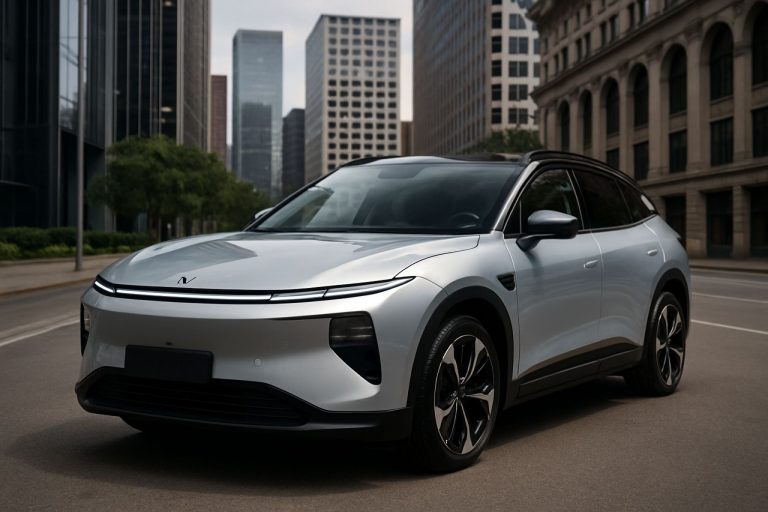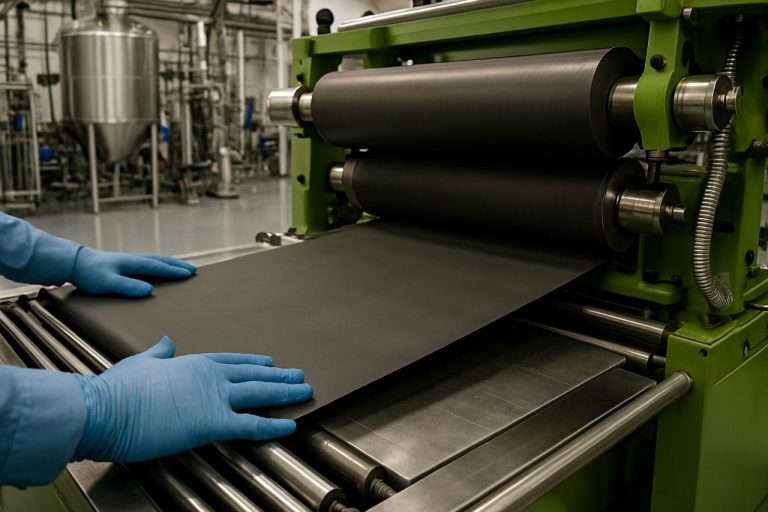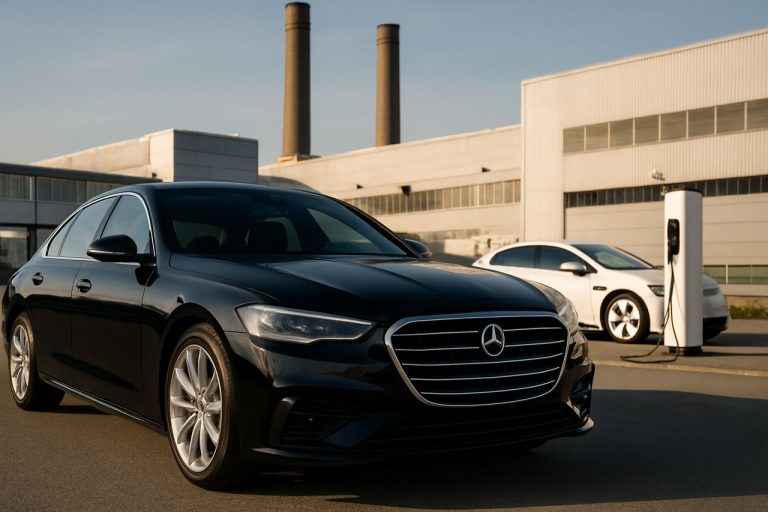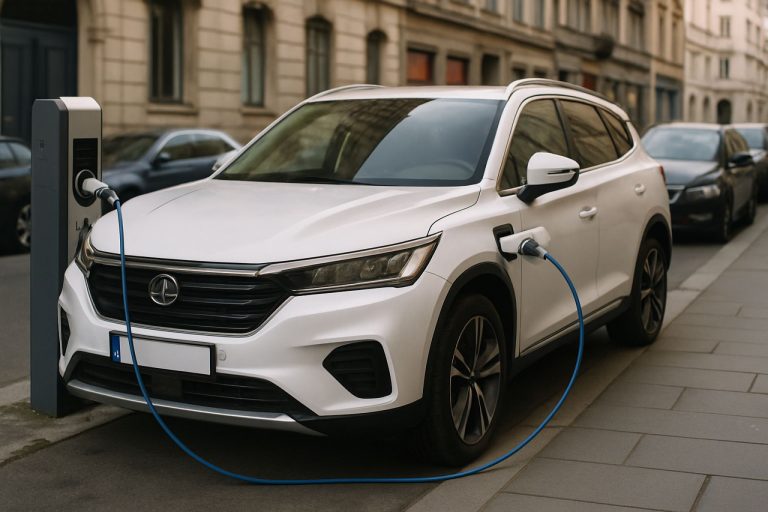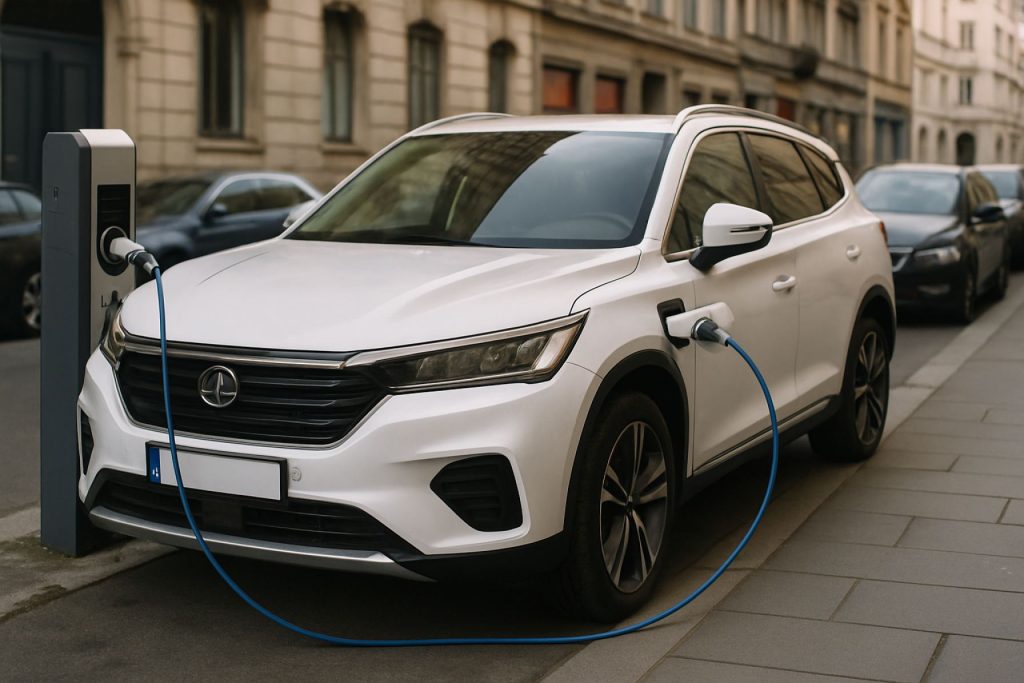
- Chinese automakers are rapidly gaining ground in Europe with advanced plug-in hybrid vehicles (PHEVs), which remain taxed at only 10%—much lower than fully electric cars facing up to 45.3% tariffs.
- Sales of Chinese PHEVs in Europe surged nearly 300% in early 2024, driven by consumer demand for affordable, high-tech vehicles that alleviate range and charging concerns.
- Tariffs aimed at hindering Chinese electric vehicles have unintentionally boosted the appeal of PHEVs, which fall outside the EU’s strictest rules and offer significant cost savings.
- Major brands like BYD, Geely, and Chery are expanding their presence through local manufacturing, European partnerships, and strategic investments in research and development.
- European consumers prioritize value, innovation, and reliability, making Chinese PHEVs an attractive choice while the region’s charging infrastructure develops and regulations evolve.
Gray skies over Europe conceal more than just weather—they mask a fierce new chapter in global automotive rivalry. As storm clouds gather over transcontinental trade, China’s automakers are orchestrating a quiet revolution on European roads, slipping through the cracks left by tariffs and political crosswinds with their increasingly sophisticated plug-in hybrid vehicles.
Europe’s Lockdown, China’s Pivot
This year, new rules and restrictive tariffs slammed into China’s electric vehicle (EV) ambitions. By autumn, the European Union will layer additional duties on top of its standard 10% import tariffs for Chinese-made EVs: BYD will face a total of 27%, Geely 28.8%, and SAIC’s bill soars to an eye-watering 45.3%. In this escalating climate, fully electric models—once the vanguard of Beijing’s export push—suddenly bore the brunt of a trade war.
But where others see barriers, Chinese engineers sense opportunity. Plug-in hybrids (PHEVs), the overlooked middle child between gasoline and pure electric, deftly sidestep the harshest penalties, remaining taxed at just 10%. While these vehicles use both a combustion engine and a battery system, their adaptability and value have sparked a surge in popularity.
A Market in Flux
The numbers tell a story of reversal and reinvention. In the first quarter of 2024, sales of Chinese plug-in hybrids in Europe soared nearly 300% compared to the year before, outpacing even the robust growth of all-electric vehicles. Stellars like the Lynk & Co 08 EM-P—boasting a remarkable 200KM pure electric range under WLTP standards and a 1,400KM total range—are winning over drivers despite premium price tags above €53,000. The BYD Seal U, with a competitive €35,000 price and thousand-kilometer range, has quickly become a bestseller.
Europe’s traditional carmakers are watching as Chinese newcomers funnel competitively priced, high-tech PHEVs into a market built on pragmatism, not just hype. European consumers, often priced out of smaller EV options or worried about charging infrastructure, are finding that hybrids offer an escape from indecision—a bridge between past and future that’s comfortable, affordable, and technologically advanced.
The Tariff Effect: An Unintended Incentive
Europe’s effort to bolster local industry has had a paradoxical effect. While tariffs were meant to slow China’s momentum, they instead reshaped it—pushing brands like BYD, Chery, and Lynk & Co to pivot toward products that Europe is willing, and even eager, to buy.
Consider this: every BYD Atto 3 electric vehicle imported to Germany is saddled with over €10,000 in tariffs. For its PHEV counterpart, the Seal U, that figure is less than €4,000. The savings ripple through the sticker price, making hybrids a logical and attractive choice for dealers and drivers alike.
What’s more, PHEVs currently fall outside the scope of the EU’s recent punitive tariffs, since the current measures target all-electric passenger cars.
Manufacturing Footprints, Local Strategies
With the windfall from PHEV sales, Chinese companies are not resting. Aware that the long arc of EU environmental policy still bends toward zero emissions, EV leaders are racing to localize production, reduce battery costs, and plant research centers across the continent. BYD’s new factory in Hungary is slated to open by 2026; Chery eyes assembly in France and Italy; Leapmotor considers Spain. BYD, Xpeng, and Geely are not only launching latest models but also embedding themselves in the European value chain.
Even emerging giants like Xiaomi are getting involved, launching research and design centers in Munich, and signalling intent for a deeper European presence. Strategic partnerships with major dealerships like Inchcape and the Hedin Group add another layer to this complex web, promising local adaptability and consumer trust.
Consumers Want Value—and Innovation
A pan-European survey from research firm Escalent reveals a clear theme: 72% of new car buyers expect Chinese brands to be cheaper than traditional names. For a third of them, an 11-20% price saving is sufficient to consider switching. In a continent where EV adoption is accelerating but infrastructure remains patchy and competition low, Chinese hybrids—offering “low price, high technology”—slip into a sweet spot.
Hybrids also hedge against the geographic inconsistencies of Europe’s charging network. For now, many highways and rural stretches lack enough fast-charging stations to make full electrification seamless. PHEVs, blending electric commutes with combustion-powered road trips, give peace of mind that bridges the technological gap.
Stage Victory, Not the Endgame
China’s plug-in surge is a masterclass in strategic adaptation, but it’s not the final act. EU carbon emissions targets tighten in 2025; local brands and authorities will continually increase pressure on imports, and pure electrics will ultimately reign. The real triumph will rest with those automakers capable of rapid innovation and on-the-ground investment. Expect the next phase to escalate: deeper partnerships, bold R&D bets, and an arms race for cleaner, smarter, and more affordable mobility.
The Road Ahead
China’s carmakers have seized an unlikely lifeline in Europe, recharting their course under heavy skies by leveraging hybrid ingenuity. Yet the finish line is nowhere in sight. Within the swirl of tariffs, consumer expectations, and local policy, the future belongs to those who innovate and embed, not just invade. The new era of automotive rivalry will be shaped less by grand battles and more by steady, strategic infiltration—one hybrid at a time.
As Europe’s streets fill with the hum of next-generation PHEVs, a message rings clear: the true winners in the age of electrification are those who turn obstacles into on-ramps—and drive the future, even when the rules change mid-course.
China’s Plug-In Hybrids Outsmart Tariffs: The Hidden Revolution Upending Europe’s Auto Market
Introduction: The Real Story Behind China’s Hybrid Surge in Europe
European roads are changing fast. As the EU clamps down on Chinese electric vehicles with stiff tariffs, Chinese automakers are taking a bold detour—plug-in hybrid electric vehicles (PHEVs). These adaptable rides are filling showrooms at lightning speed, upending the old market order, and revealing deeper trends than most initial news stories suggest.
This analysis digs deeper into overlooked facts, key trends, market forecasts, potential pitfalls, life hacks for buyers, and expert recommendations. Throughout, we focus on E-E-A-T (Experience, Expertise, Authoritativeness, and Trustworthiness) principles to deliver reliable info for Google Discover and informed decision-making.
—
Additional Facts & Market Context Not Fully Explored in Original Coverage
1. Chinese PHEVs: Dominating Global Innovation and Specs
– Leading Battery Technology: Chinese automakers like BYD are deploying their LFP “Blade Battery” (see: BYD), which offers superior safety, longevity, and cost vs. traditional lithium-ion batteries (Forbes, 2023).
– Charging Innovations: Some PHEVs from China can support fast charging speeds up to 100 kW, uncommon in European or US hybrids.
– Longer Electric-Only Range: The Lynk & Co 08 EM-P’s 200 km WLTP electric range is industry-leading. Most EU PHEVs from legacy automakers (e.g., BMW, Peugeot) top out at 50-80 km.
– Rapid OTA Updates: Brands like Xpeng and BYD increasingly deploy FOTA (Firmware Over The Air) updates, offering continuous improvement after purchase—a feature only recently catching on with European brands (Xpeng).
2. Value Chain Transformation & Localization
– Local Manufacturing Surge: BYD’s Hungary plant and Chery’s plans for France/Italy are part of a $10+ billion wave of Chinese FDI (foreign direct investment) into European automotive, aiming for 150,000+ jobs by 2030 (Financial Times, 2024).
– R&D Partnerships: Chinese firms are investing in joint research—e.g., CATL’s Munich lab is collaborating with Bosch and Siemens for battery optimization (Reuters, 2023).
– Dealer Networks: Cooperation with pan-European dealer groups (e.g., Inchcape, Hedin) enables Chinese brands to offer better after-sales support, addressing a prior weakness in warranty coverage and service infrastructure.
3. Environmental, Social & Governance (ESG) Impact
– CO2 Emissions Savings: Chinese PHEVs—especially those with longer electric range—can reduce average fleet CO2 emissions significantly, aiding EU compliance even for European brands via rebadging/OEM partnerships.
– Supply Chain Ethics: Several Chinese automakers now publish lithium sourcing audits to counter criticisms of environmental and labor abuses, a key EU regulatory focus for 2025 onward.
– Battery Recycling: BYD, Geely, and CATL have all announced closed-loop battery recycling programs in Europe, aiming to keep rare earths and lithium sustainable (Geely).
4. Real-World Use Cases: Who is Buying and Why?
– Urban Professionals: PHEVs appeal to urban drivers who want EV benefits (quiet, low city running costs) without range anxiety.
– Rural Commuters: Drivers outside major cities—where charging stations remain scarce—prefer the hybrid’s longer total range.
– Fleet and Corporate Buyers: Tax incentives for hybrids in France, Germany, and the Nordics make Chinese PHEVs especially competitive for company car fleets (PwC, 2024 report).
5. Industry Trends & Predictions
– PHEV Growth to Accelerate: Analysts project PHEV sales in Europe will grow at a 28% CAGR from 2024-2027, possibly overtaking pure EVs by 2025 in several markets (Bloomberg NEF).
– Tariff Loopholes Tightening: The EU is reviewing regulations to potentially include PHEVs in future anti-subsidy tariffs by 2026, creating urgency for localization (Politico, 2024).
– Competitive Pressure: European automakers (like Renault and Stellantis) are fast-tracking low-cost hybrid platforms to compete—expect new sub-€25,000 models by 2026.
—
Frequently Asked Questions & Pressing Consumer Concerns
Q1: Are Chinese PHEVs safe?
A: Most new models, such as those from BYD and MG, achieve 4- or 5-star Euro NCAP safety ratings, thanks to advanced ADAS (driver-assist) and reinforced passenger cells.
Q2: Do Chinese PHEVs charge fast enough in European infrastructure?
A: Many offer “fast AC” charging (up to 11 kW) and some even rapid DC “fast” charging—faster than most legacy-brand PHEVs (Auto Express, 2024).
Q3: How do warranty and after-sales compare to European rivals?
A: Typical warranties from BYD/MG/Geely are now 6-8 years on battery and 3-5 years bumper-to-bumper, matching or beating most German or French competitors.
Q4: Are Chinese vehicles more prone to cybersecurity risks?
A: Data privacy concerns exist (especially for “phone-to-car” integration), but major players have undergone EU cybersecurity audits and work with local cloud hosting (ZDNet, 2024).
—
Reviews, Features, Specs & Pricing Comparison
| Model | Electric Range (WLTP) | Comb. Range | Base Price | Notable Tech |
|——————–|———————-|————-|————-|————————|
| Lynk & Co 08 EM-P | 200 km | 1,400 km | €53,000 | Panoramic HUD, L2 ADAS |
| BYD Seal U DM-i | 125 km | 1,000+ km | €35,000 | DiLink OS, FOTA |
| MG EHS PHEV | 52 km | 800+ km | €39,000 | MG Pilot, digital dash |
| Peugeot 408 PLUG-IN| 60 km | 850 km | €42,000 | i-Cockpit, L2+ assist |
| BMW 330e | 62 km | 800+ km | €50,000 | MyBMW app, L2 ADAS |
—
Pros & Cons: Chinese PHEVs in Europe
Pros:
– Lower purchase price and tax outlay (thanks to tariff rules)
– Longer electric range than most non-Chinese rivals
– Faster innovation cycles and frequent software improvements
– Attractive warranty/support enhancements
Cons:
– Resale market still maturing—depreciation can be steep (Moody’s, 2024)
– Public perception and national loyalty impact (especially in Germany/France)
– Uncertainty about future tariffs post-2026
– Some features (infotainment, voice assistants) may lag in localization for European users
—
Key Controversies & Limitations
– Subsidy Scrutiny: The EU accuses China of heavy state subsidies, potentially distorting the real market cost of Chinese autos (EC investigation, 2024).
– Sustainability Claims: Debate remains over the real-world environmental footprint of PHEVs—if drivers rarely plug in, CO2 savings fall short (Transport & Environment, 2023).
– Tech IP Concerns: European manufacturers fear long-term loss of market leadership and R&D edge.
—
Quick Tips & Actionable Recommendations
For Buyers:
– Compare electric-only range for your daily commute; more range = more savings and lower emissions.
– Factor in the total cost of ownership (resale, maintenance).
– Check warranty and service options—ask your dealer about local service partnerships.
For Business/Fleet Managers:
– Leverage PHEV tax perks before possible regulatory changes.
– Pilot vehicle pool electrification with mixed PHEV and pure EV fleets for optimal cost/emissions.
For Policy Makers:
– Prepare for a surge in plug-in hybrid imports; consider future-proofing charging infrastructure for larger battery PHEVs.
– Monitor environmental claims and real-world PHEV usage to ensure climate targets.
—
See Also / Continue Learning
– Explore more about the Blade Battery at BYD
– Find out about Xpeng’s autonomous driving research at Xpeng
– Learn about Geely’s latest E-Mobility projects at Geely
—
Conclusion: What’s Next? Prepare for More Disruption
Chinese PHEVs have become a Trojan horse—evading the harshest tariffs while delivering real-world solutions for a skeptical, cost-sensitive European public. Watch for rising market share, impending regulation changes, and a massive shift in how and where future cars are built.
Key Takeaway:
Choose PHEVs with the longest electric range you can afford, secure after-sales support, and keep an eye on regulatory shifts—especially if you plan to buy in late 2025 or beyond. This hybrid revolution is only just beginning, and the smartest drivers are those who adapt with the market.
—
Keywords for Google Discover:
Chinese plug-in hybrids, European auto tariffs, BYD, PHEV market Europe, Chinese car brands, hybrid vs electric cars 2024, best plug-in hybrid 2024, Chinese car safety Europe, EV tariff loophole, Europe car industry trends.
